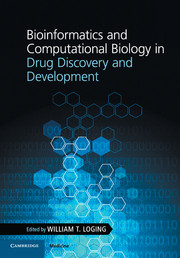Book contents
- Frontmatter
- Contents
- List of contributors
- Foreword: The future of drug discovery and healthcare
- Acknowledgments
- 1 The art and science of the drug discovery pipeline
- 2 Computational approaches to drug target identification
- 3 Understanding human disease knowledge through text mining
- 4 Integrating translational biomarkers into drug development
- 5 Computational phenotypic assessment of small molecules in drug discovery
- 6 Data visualization and the DDP process
- 7 Information visualization – important IT considerations
- 8 Example of computational biology at the new drug application (NDA) and regulatory approval stages
- 9 Clinical trial failures and drug repositioning
- Appendix I Additional knowledge-based analysis approaches
- Appendix II Open source tools and public data sources
- Index
- Plate section
- References
9 - Clinical trial failures and drug repositioning
Published online by Cambridge University Press: 05 February 2016
- Frontmatter
- Contents
- List of contributors
- Foreword: The future of drug discovery and healthcare
- Acknowledgments
- 1 The art and science of the drug discovery pipeline
- 2 Computational approaches to drug target identification
- 3 Understanding human disease knowledge through text mining
- 4 Integrating translational biomarkers into drug development
- 5 Computational phenotypic assessment of small molecules in drug discovery
- 6 Data visualization and the DDP process
- 7 Information visualization – important IT considerations
- 8 Example of computational biology at the new drug application (NDA) and regulatory approval stages
- 9 Clinical trial failures and drug repositioning
- Appendix I Additional knowledge-based analysis approaches
- Appendix II Open source tools and public data sources
- Index
- Plate section
- References
Summary
More than 90% of compounds entering clinical trials fail to reach the market; thus, any company with a history in drug development has a large number of failed compounds “sitting on the shelf.” Each of these compounds has a substantial portfolio of associated data and represents a significant sunk cost. This chapter discusses methods to find new uses for failed clinical-stage compounds (repositioning), and highlights a specific current example to discuss the unique development considerations for a repositioned compound.
Background
There is a long and rich history of successful drug repositioning. This includes repositioning of compounds during their first clinical development program, repositioning of compounds that failed in their original development program, and repositioning (or line extension) of marketed drugs. Selected examples are shown in Table 9.1. While the development strategies for new uses of marketed and failed compounds differ in regulatory, intellectual property and market protection considerations, the strategies for exploring for new uses are similar.
There has recently been a concerted effort in many pharmaceutical companies to systematically review all failed clinical candidates (FCC). This is driven by several considerations. First, there is general recognition that the highly focused approach necessary in the original development may have precluded consideration of all possible uses. Second, modern compound testing and data analysis paradigms are readily optimized for repositioning. Third, when a new development path is found, the development cost for an FCC could be significantly lower than the cost of de novo development of a new compound, as a large amount of proprietary non-clinical and clinical data exist for the FCC.
- Type
- Chapter
- Information
- Publisher: Cambridge University PressPrint publication year: 2016



